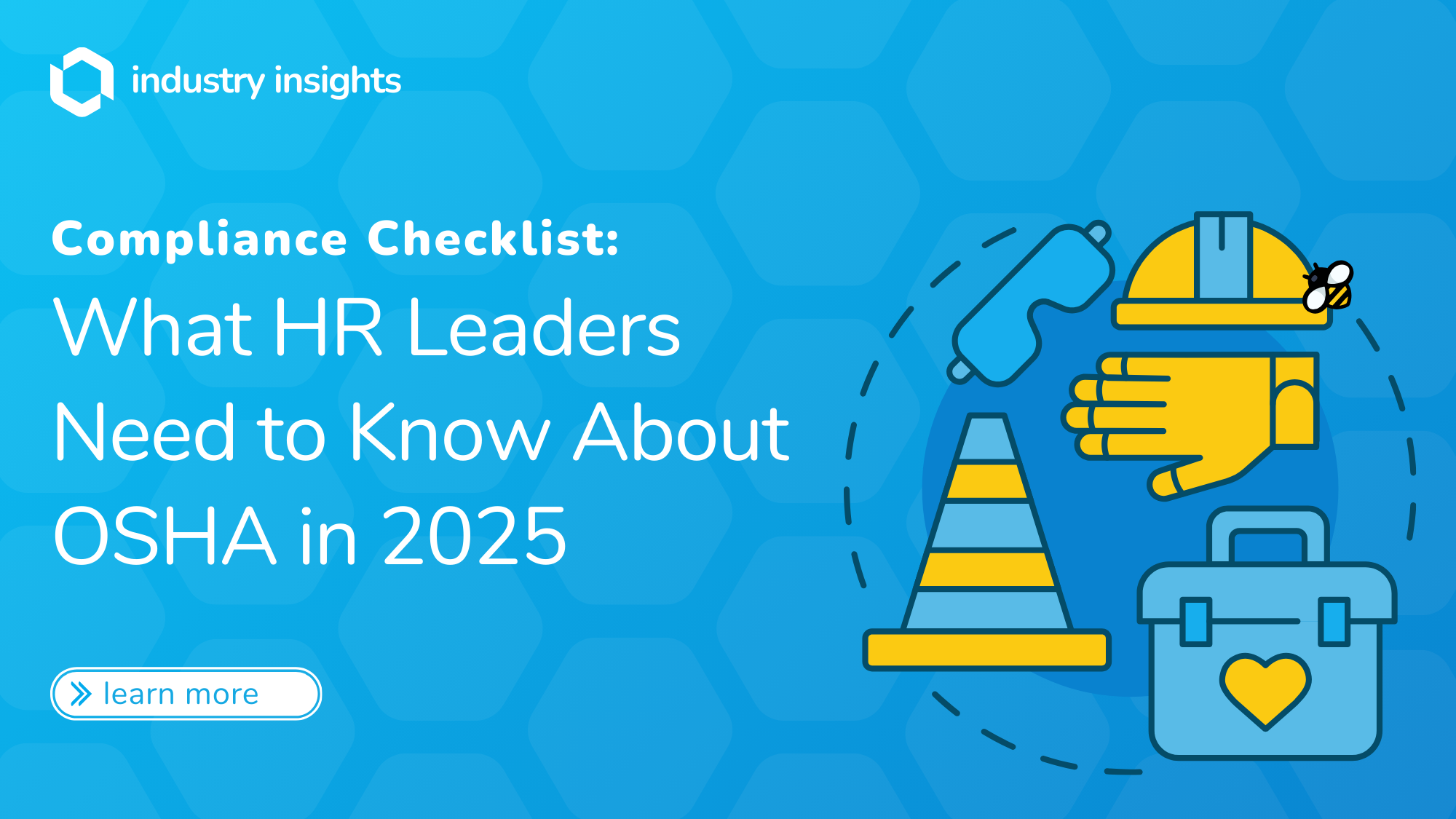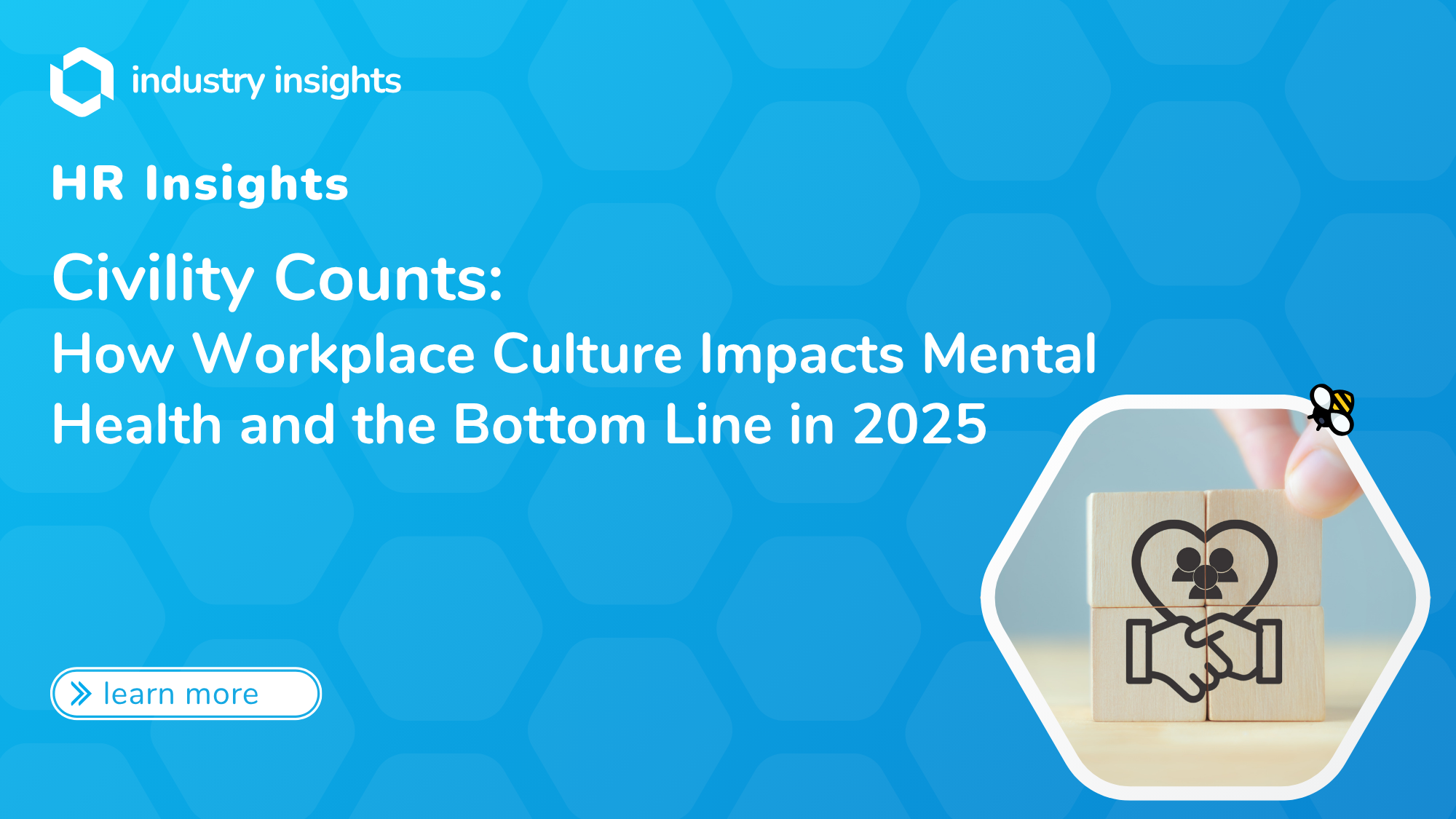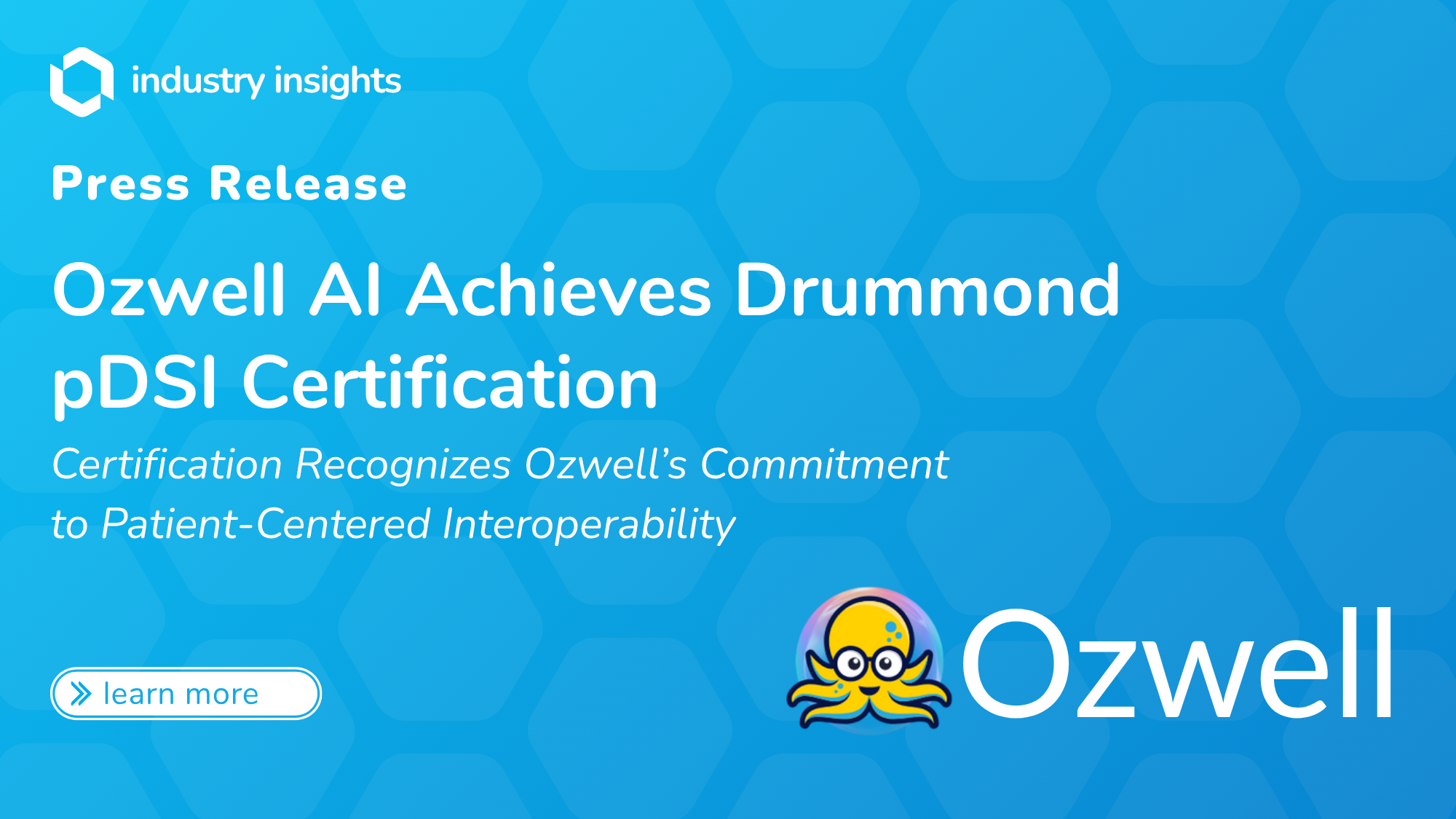The Occupational Safety and Health Administration (OSHA) updates its regulations yearly to meet the demands of a changing workforce and work environment. Staying ahead of these changes ensures compliance, avoids penalties, and protects your workforce’s safety and health.
In 2025, OSHA plans to update safety standards, reporting requirements, and compliance guidelines. These changes will reflect emerging challenges such as technological advancements, remote working, and a heightened focus on employee well-being. Your team will need to be proactive in planning for these updates. Clear communication and practical tools will help you meet compliance demands across diverse industries.
This whitepaper will discuss upcoming changes and offer actionable insights to help you and your team remain compliant, mitigate risks, reduce administrative burdens, and ensure your workforce operates safely and efficiently.
Key Changes to OSHA Regulations in 2025
- Expanded Remote Work Compliance Standards: While remote work became necessary during the COVID-19 pandemic, many organizations have maintained a remote workforce. Employers must ensure that remote employees’ home offices meet basic safety standards, such as ergonomic setups and safe electrical practices. While not as easily enforceable as on-site inspections, these standards represent a growing focus on the health and safety of remote employees (ADP, 2024).
- Enhanced Reporting and Record-Keeping Requirements: In 2025, OSHA will tighten its rules for reporting workplace incidents and maintaining records. Electronic submissions are expected to become mandatory for more businesses, assisting in real-time data collection. These changes will streamline OSHA’s ability to identify safety trends and enforce regulations, but they will require your team to upgrade their reporting processes and tools.
- Focus on Psychological Safety: OSHA plans to expand its definition of a safe workplace to include psychological well-being. These expanding standards may require your organization to address issues such as workplace stress, harassment, and other items attributed to mental health concerns. As such, your team will need to integrate mental health resources and training into your compliance programs.
- Industry-Specific Updates: Certain industries, such as construction, healthcare, and manufacturing, will face additional regulatory updates. For example, construction teams may see updates to fall protection standards and regulations implemented to reduce heat-related workplace injuries. Healthcare providers may see new and stricter rules on exposure to airborne pathogens. Staying informed of changes specific to your organization’s industry will be key to remaining compliant.
- Increased Inspection and Enforcement: In addition to the measures mentioned above, OSHA plans to increase the number of on-site inspections, especially in high-risk industries, focusing on repeat offenders and workplaces with a history of non-compliance. With penalties for violations climbing, your organization will need your team to be on its A-game.
Common Compliance Challenges HR Leaders Face
With changed regulations and standards, OSHA compliance can present a unique challenge for HR teams like yours. From managing diverse teams to navigating evolving regulations, ensuring compliance requires proactive strategies and efficient systems. Here are some common hurdles that you may encounter:
- Managing Compliance Across Diverse Workforces: In today’s dynamic work environment, your workforce likely spans full-time, part-time, remote, and contract workers. Each group has unique compliance requirements, making tracking and managing certifications, vaccinations, safety training, and health screenings more complicated for your team. Remote employees, in particular, may present new challenges as OSHA begins addressing home office safety.
- Keeping Up with Evolving Regulations: OSHA regulations change frequently, often requiring you to update policies and train employees on new standards. Your team needs a centralized system to track these changes and ensure compliance, ensuring your organization is not exposed to risks or penalties.
- Limited Resources for Compliance Oversight: Many HR teams already handle recruitment, employee engagement, and benefits administration. Adding compliance to the workload of a team that is already stretched thin can lead to overlooked deadlines, missed certifications, and errors in reporting, which is especially true for smaller organizations with limited HR resources.
- Inadequate Record-Keeping Systems: Effective compliance relies on effective record-keeping, which can be difficult for organizations that still rely on outdated or manual processes. Missing or misfiled documentation can result in hefty fines during OSH on-site inspections.
- Cost of Non-Compliance: The financial consequences of non-compliance are steep. OSHA fines can range from thousands to millions of dollars, depending on the severity and frequency of the violations. In addition to monetary penalties, non-compliance can damage your organization’s reputation, reduce employee morale, and harm client relationships (OSHA, 2024).
Proactive Steps for Staying OSHA-Compliant
To ensure compliance with OSHA in 2025, you and your team must take a proactive approach that combines strategic planning, employee engagement, and efficient systems. By addressing potential issues before they escalate, you can reduce compliance risks, avoid penalties, and build a safer, more resilient workforce. Here are a few key steps to consider:
- Conduct Regular Workplace Audits: One of the quickest ways to spot gaps in compliance is by performing routine audits. During these audits, you and your team can review safety procedures, check for expiring certifications, and evaluate your workplace for hazards. Audits prepare you for upcoming OSHA regulation changes and potential in-person inspections.
- Leverage Digital Tools for Compliance Management: One of the leading contributors to compliance issues is how organizations track their employees’ certifications, vaccinations, and screenings. If your team can implement a digital compliance platform, you can automate reminders for renewals, track required training, and monitor compliance data. These tools can streamline processes, reduce administrative burdens, and provide a centralized view of your workforce.
- Invest in Employee Training and Development: Changes in regulations or standards often require that your workforce receive new or refreshed training. Through employee education, your team can ensure that your workforce is educated on safety protocols, reporting procedures, and the importance of remaining compliant.
- Prioritize Employee Well-Being: You can promote a safe workplace by encouraging employees to participate in organization-sponsored vaccination clinics, health screenings, and ergonomic assessments. These measures can help to reduce absenteeism and prevent workplace injuries. Focusing on employee well-being demonstrates your commitment to creating a supportive and productive work environment (Centers for Disease Control and Prevention, 2024).
- Stay Informed About Regulatory Changes: OSHA regulations can evolve quickly, and staying informed is critical. You and your team should subscribe to OSHA updates, attend industry-specific webinars, and participate in compliance workshops. Doing so will help you remain up-to-date on the latest requirements and allow you to enact policies and training programs before they become urgent or result in penalties.
The Compliance Checklist for 2025
One of the easiest ways to ensure that your employees remain compliant is to construct a checklist that covers all essential areas. This actionable guide is designed to help you and your team proactively address critical compliance requirements.
- Training and Certification
- Ensure all employees complete OSHA training based on their roles and industry (e.g., fall protection, hazard communication).
- Verify certifications for specialized roles, such as forklift operators or confined space workers.
- Schedule refresher training for expiring certifications and distribute updated training materials.
- Record-Keeping and Reporting
- Maintain updated records of workplace incidents, near-misses, and employee health screenings.
- Transition to electronic reporting systems to meet OSHA’s enhanced data submission requirements.
- Conduct internal audits of your record-keeping system to ensure accuracy and compliance.
- Health and Safety Protocols
- Confirm that all work environments, including remote workspaces, meet OSHA physical and ergonomic safety standards.
- Promote preventative health measures such as vaccination clinics, health screenings, and wellness initiatives.
- Regularly update emergency action plans and conduct safety drills.
- Inspections and Audits
- Schedule regular workplace safety audits to identify hazards and address potential compliance gaps.
- Prepare for OSHA inspections by creating a checklist of required documentation and safety protocols.
- Ensure key team members are trained to handle OSHA visits professionally and effectively.
- Employee Engagement and Communication
- Regularly communicate compliance updates and safety protocols to your workforce.
- Empower employees to report potential hazards and provide feedback on workplace safety.
- Offer clear, accessible resources on compliance expectations and requirements.
- Digital Tools and Automation
- Implement a centralized compliance platform to track certifications, screenings, and safety records.
- Automate reminders for training renewals, health screenings, and reporting deadlines.
- Use analytics tools to identify trends in workplace safety and make data-driven improvements.
How BlueHive Supports OSHA Compliance
Managing OSHA compliance in 2025 doesn’t have to be a daunting task. BlueHive’s innovative platform is designed to help HR teams streamline compliance processes, reduce administrative burden, and ensure your workforce remains compliant, safe, and productive. Here’s how BlueHive can simplify your compliance efforts:
- Centralized Compliance Tracking: BlueHive’s platform centralizes all employee compliance data, including certifications, training records, and health screenings. This will enable you to access compliance statuses in real time and eliminate the need for manual record-keeping.
- Automated Notifications and Reminders: With BlueHive, you can automate notifications for expiring certifications, upcoming training sessions, and reporting deadlines. These reminders ensure that you and your team stay informed and reduce the risk of missed compliance tasks.
- Nationwide Network of Health Providers: With BlueHive, you can utilize our nationwide network of over 18,000 providers, allowing you to schedule screenings, drug tests, and certifications for your employees – no matter their location.
- Real-Time Insights and Analytics: BlueHive’s platform provides real-time reporting and analytics, offering insights into compliance trends, identifying potential risks, and pointing out areas that could use improvement. You and your team can then utilize the analytics to address workplace safety concerns before they escalate.
- HIPAA-Compliant Data Security: BlueHive ensures that all employee compliance data is stored and accessed securely. This security complies with HIPAA data privacy and security standards and protects your organization from data breaches while maintaining employee trust.
Conclusion
OSHA compliance is more than just a regulatory obligation – it’s a cornerstone of workplace safety, productivity, and employee well-being. As an HR leader, your ability to stay ahead of evolving regulations and proactively address compliance challenges is critical to protecting your workforce and organization.
BlueHive is here to empower your team to meet these challenges head-on. With our centralized platform, automated compliance tracking, and robust provider network, BlueHive simplifies the complexity of OSHA compliance. This will allow your team to focus on supporting your employees and maintaining a safe, healthy, and productive workplace.
Don’t let 2025’s OSHA regulatory updates cause you and your team stress in the coming year. Let BlueHive help you navigate the complexities of OSHA compliance confidently and efficiently. Together, your team and BlueHive can help create a safer, more efficient workplace ready for whatever challenges the year may bring.
Sources:
ADP. (n.d.). Remote workers & workplace safety: Know your responsibilities. Retrieved December 9, 2024, from https://sbshrs.adpinfo.com/blog/remote-workers-workplace-safety-know-your-responsibilities
Centers for Disease Control and Prevention. (n.d.). The workplace health model. Retrieved December 9, 2024, from https://www.cdc.gov/workplace-health-promotion/php/model/index.html
Occupational Safety and Health Administration. (n.d.). OSHA enforcement cases: Lessons from significant penalties. Retrieved December 9, 2024, from https://www.oshaoutreachcourses.com/blog/osha-enforcement-cases




